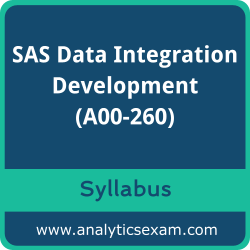 Welcome to your one-stop solution for all the information you need to excel in the SAS Data Integration Development for SAS 9 (A00-260) Certification exam. This page provides an in-depth overview of the SAS A00-260 Exam Summary, Syllabus Topics, and Sample Questions, designed to lay the foundation for your exam preparation. We aim to help you achieve your SAS Certified Data Integration Developer for SAS 9 certification goals seamlessly. Our detailed syllabus outlines each topic covered in the exam, ensuring you focus on the areas that matter most. With our sample questions and practice exams, you can gauge your readiness and boost your confidence to take on the SAS Data Integration Development exam.
Welcome to your one-stop solution for all the information you need to excel in the SAS Data Integration Development for SAS 9 (A00-260) Certification exam. This page provides an in-depth overview of the SAS A00-260 Exam Summary, Syllabus Topics, and Sample Questions, designed to lay the foundation for your exam preparation. We aim to help you achieve your SAS Certified Data Integration Developer for SAS 9 certification goals seamlessly. Our detailed syllabus outlines each topic covered in the exam, ensuring you focus on the areas that matter most. With our sample questions and practice exams, you can gauge your readiness and boost your confidence to take on the SAS Data Integration Development exam.
Why SAS Data Integration Development Certification Matters
The SAS A00-260 exam is globally recognized for validating your knowledge and skills. With the SAS Certified Data Integration Developer for SAS 9 credential, you stand out in a competitive job market and demonstrate your expertise to make significant contributions within your organization. The SAS Data Integration Development for SAS 9 Certification exam will test your proficiency in the various syllabus topics.
SAS A00-260 Exam Summary:
| Exam Name | SAS Data Integration Development for SAS 9 |
| Exam Code | A00-260 |
| Exam Duration | 105 minutes |
| Exam Questions | 52 |
| Passing Score | 69% |
| Exam Price | $180 (USD) |
| Books / Training | SAS Data Integration Studio: Fast Track |
| Exam Registration | Pearson VUE |
| Sample Questions | SAS Data Integration Developer Certification Sample Question |
| Practice Exam | SAS Data Integration Developer Certification Practice Exam |
SAS A00-260 Exam Syllabus Topics:
| Objective | Details | Weight |
|---|---|---|
| Overview |
- Define the architecture of the platform for SAS Business Analytics. - Describe the available SAS Data Integration Studio interface - Define the change management feature of SAS Data Integration Studio. |
(5% – 6%) |
| Creating Metadata for Source and Target Data |
- Define administrative tasks to be performed for SAS Data Integration Studio. - Describe the New Library Wizard. - Use Register Tables wizard to register source data.
- Use Register Tables wizard to register metadata for a Microsoft Access database table using ODBC.
|
(19% – 20%) |
| Creating Metadata for Target Data and Jobs |
- Describe features of the New Table wizard. - Discuss components of Join's Designer window including:
- Investigate mapping and propagation.
- Generate reports on metadata for tables and jobs. |
(17 – 18%) |
| Working with Transformations |
- Discuss and use the Extract and Summary Statistics transformation. - Discuss and use the Loop transformations.
- Investigate where status handling is available.
- Discuss and use the Rank, Transpose, Append, List and Sort transformations. |
(21% – 22%) |
| Working with Tables and the Table Loader Transformation |
- Discuss reasons to use the Table Loader transformation. - Discuss various load styles provided by the Table Loader transformation. - Discuss various types of keys and how to define in SAS Data Integration Studio. - Discuss indexes and how to define in SAS Data Integration Studio. - Discuss Table Loader options for keys and indexes. - Discuss the Bulk Table Loader transformation. - Discuss and use the components of the Join’s Designer Window related to in database processing |
(17 –
18%)
|
| Defining Generated Transformations |
- Define SAS code transformation templates. - Create a custom transformation |
(5% – 6%) |
| Deploying Jobs |
- Discuss the types of job deployment available for SAS Data Integration Studio Jobs. - Provide an overview of the scheduling process. |
(5% – 6%) |
| In Database Processing |
- Define in- database processing
- Enable in-database processing. |
(7% – 8%) |
The SAS has created this credential to assess your knowledge and understanding in the specified areas through the A00-260 certification exam. The SAS Certified Data Integration Developer for SAS 9 exam holds significant value in the market due to the brand reputation of SAS. We highly recommend thorough study and extensive practice to ensure you pass the SAS Data Integration Development for SAS 9 exam with confidence.
